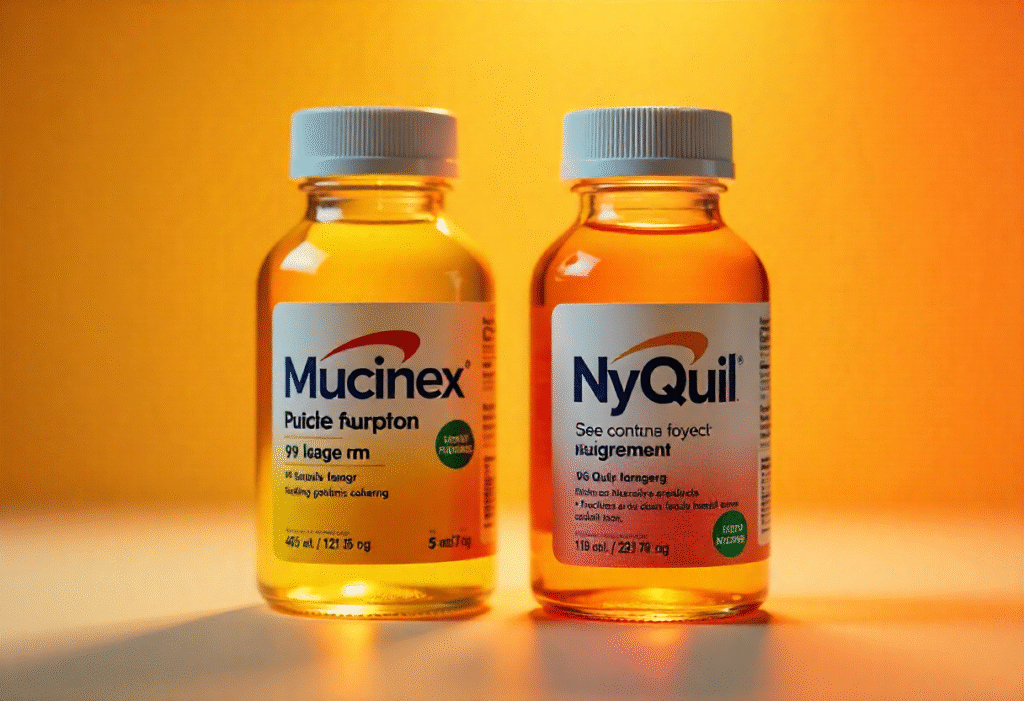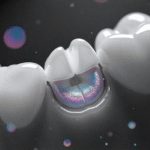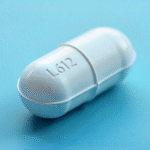Cold and flu season often leaves people juggling medications for cough, congestion, and body aches. One of the most common questions is: can you take Mucinex and NyQuil together? Both are widely available, and both aim to make you feel better — but they work in different ways. Mucinex is primarily an expectorant, helping thin and loosen mucus in your airways, while NyQuil is a multi-symptom nighttime relief medicine containing several ingredients. The answer depends on the exact formulation of each, your health condition, and timing. Knowing the right approach can prevent side effects and keep your recovery smooth.
Understanding Mucinex
Mucinex’s active ingredient is guaifenesin. Its main job is to thin mucus so it’s easier to cough up. Available in different forms like Mucinex DM and Mucinex D, some versions also contain cough suppressants or decongestants. It’s generally taken during the day because it doesn’t cause significant drowsiness. People with chronic bronchitis or chest congestion often find it helpful.
Understanding NyQuil
NyQuil is designed for nighttime use and usually contains acetaminophen for pain and fever, dextromethorphan as a cough suppressant, and doxylamine succinate as an antihistamine to help with runny nose and promote sleep. Its sedative effect is one of the main reasons it’s not recommended during the day if you need to be alert.
Can You Take Mucinex and NyQuil Together?
If you take plain Mucinex and standard NyQuil, there is usually no direct harmful interaction. However, if you take Mucinex DM, which already contains dextromethorphan, you may double up on that ingredient by also taking NyQuil — increasing the risk of side effects like dizziness, confusion, or slowed breathing. Reading labels before combining is crucial.
How They Work in the Body
Mucinex thins mucus in your chest, making coughs more productive. NyQuil works to suppress coughing, relieve pain, reduce fever, and help you sleep. Taking both might seem counterintuitive — one encourages coughing, the other suppresses it — but it can make sense if you use Mucinex during the day and NyQuil at night, keeping symptoms in check without excessive overlap.
Similarities and Overlaps in Ingredients
The main overlap risk is dextromethorphan, a cough suppressant present in both Mucinex DM and NyQuil. Too much can cause nervous system effects and even dangerous reactions in sensitive individuals. Another overlap could be acetaminophen if you’re taking other pain relievers.
Risks of Combining Mucinex and NyQuil
Potential side effects include excessive drowsiness, dizziness, upset stomach, and in rare cases, irregular heartbeat. If taken incorrectly, overdosing on shared ingredients is the biggest risk. Always stick to recommended dosages.
Safe Time Gaps Between Doses
If you want to take both on the same day, many healthcare providers recommend spacing them at least 4–6 hours apart. Mucinex during the day, NyQuil before bedtime, is a safe general pattern for most adults.
Mucinex DM vs Regular Mucinex with NyQuil
Regular Mucinex (guaifenesin only) is safer to combine with NyQuil than Mucinex DM (guaifenesin + dextromethorphan). The latter can create a duplication issue that’s best avoided unless advised by your doctor.
Interaction with Other Medications
Both Mucinex and NyQuil can interact with antidepressants, certain blood pressure medications, and other cold remedies. Always check with a healthcare provider if you are on prescription drugs.
Special Considerations for Children
Never give adult formulations of these medications to children. Pediatric dosing is different, and certain ingredients in NyQuil are not safe for kids under six years old.
Pregnancy and Breastfeeding Safety
Pregnant women should consult their OB before taking either medication, as certain ingredients may not be recommended. Breastfeeding mothers should also be cautious since some components pass into breast milk.
Chronic Illness Considerations
People with asthma, COPD, liver disease, or heart conditions need medical clearance before combining these medications. NyQuil’s acetaminophen can stress the liver, and its sedating ingredients may affect breathing.
Natural Alternatives for Cold and Flu
Warm fluids, steam inhalation, honey for cough, and rest can be effective alongside or instead of medication. Ginger tea and saline nasal rinses are time-tested remedies.
How to Read Medication Labels
Always look for active ingredients, dosage instructions, and warnings. Knowing the drug classes can prevent taking two medications that do the same thing.
Doctor’s Advice on Combining Cold Medications
Doctors often recommend targeting specific symptoms instead of taking multi-symptom formulas unnecessarily. This minimizes the number of active ingredients you’re consuming.
Best Time to Take Each
Mucinex works well during the day when you need to clear your airways. NyQuil is best reserved for bedtime to help you rest without interruptions from coughing or congestion.
Symptoms That Warrant Emergency Care
Seek medical help immediately if you experience chest pain, difficulty breathing, severe dizziness, or allergic reactions after taking these medicines.
Common Myths About Cold Medicines
One myth is that more medicine means faster healing. In reality, these drugs manage symptoms but don’t shorten illness duration.
Combining Other Cold Medications
Avoid mixing with other combination drugs like DayQuil unless you’ve confirmed there’s no ingredient duplication.
Mucinex and NyQuil Storage Safety
Keep both medications in a cool, dry place, out of reach of children. Always check expiration dates.
Managing Multiple Symptoms Without Overmedicating
Sometimes using a single-ingredient medication plus natural remedies can be more effective and safer than combining multiple drugs.
Recommended Dosage Guidelines
Follow the dosing listed on the packaging unless your doctor provides different instructions. Never exceed the daily limit for any active ingredient.
Alcohol and Medication Interactions
NyQuil contains alcohol and sedating antihistamines. Combining it with alcohol increases the risk of extreme drowsiness and liver damage.
Also read: Gum Grafting Surgery: Transform Your Smile and Oral Health
FAQs
Can you take Mucinex and NyQuil on the same day?
Yes, but ideally Mucinex in the morning and NyQuil at night to prevent overlap.
What happens if you take Mucinex DM and NyQuil together?
You may double up on dextromethorphan, increasing side effect risk.
Can children take both?
Only under pediatric guidance and never with adult-strength doses.
Is it safe during pregnancy?
Consult your doctor; some ingredients may not be recommended.
Does taking both cure the cold faster?
No, they only help manage symptoms, not shorten illness.
Can I drink alcohol with these medications?
Avoid alcohol, especially with NyQuil, due to increased sedation and liver strain.
Conclusion
Combining Mucinex and NyQuil can be safe in certain circumstances, but it is not a one-size-fits-all decision. The key is knowing exactly which versions you are using, understanding the active ingredients, and avoiding accidental duplication. Mucinex works best during the day to clear mucus, while NyQuil offers nighttime relief to help you rest. When taken at the right times and in the correct doses, they can complement each other without major issues. However, medical conditions, pregnancy, or other medications may change the safety profile. Always read labels carefully, follow dosing instructions, and consult a healthcare profess


